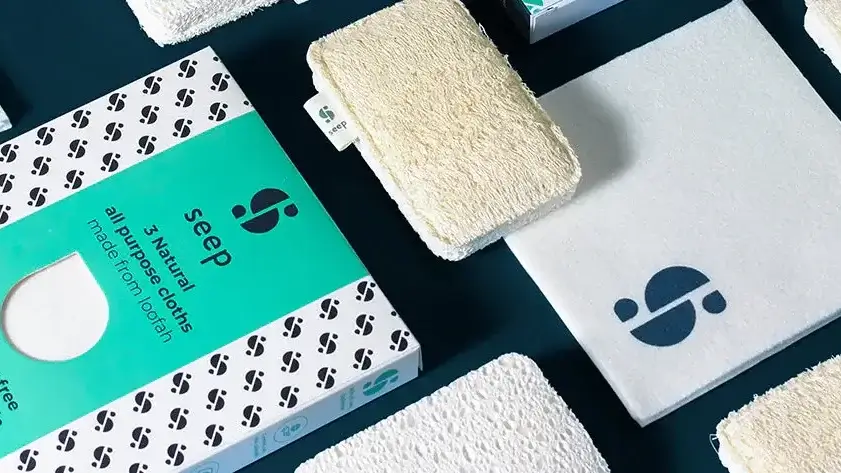Seep, a manufacturer and seller of environmentally friendly cleaning products, were looking to expand the sustainable products available to their eco-conscious customers.
Thanks to a grant from the Mayor of London’s Green New Deal fund and support from ReLondon’s ERDF-funded business transformation programme, Seep developed and tested a new cloth made from natural, sustainably sourced cellulosic fibres which are long-lasting, plastic-free and compostable.
Seep’s microfibre alternative was found to perform as well as – or better than – the current market-leading microfibre cloths and received positive feedback from customer trials. They are now seeking manufacturing partners to produce the cloths at volume and confirm their commercial viability.
What was the challenge?
Seep was established in 2020 with the mission of bringing customers better household essentials that are gentle on the planet, gentle on the eye and gentle on people. Their growing range of products are sold direct to consumers, as well as to retail and hospitality businesses, and are circular, plastic-free, climate positive and B Corp certified.
Seep launched with a core range of off-the-shelf products that were easy to source and readily available. This allowed the company to test consumer interest and demonstrate a clear market demand for circular and compostable cleaning products.

Seep believed that their eco-conscious customers, who want to make more sustainable choices, were looking for an alternative to a microfibre cloth. These cloths are a huge and growing market in the UK, but are made of polyester and responsible for large amounts of microplastics being released into the environment. Seep wanted to develop a fully circular alternative that was more ethically sourced and better performing.
The key challenge would be to replicate the physical and technical performance of a microfibre cloth (i.e. absorbency, stability, tensile strength) with something made from lower carbon, compostable fibres which is still affordable and commercially viable.
What was the response(s)?
Seep proposed a pilot to create their new microfibre alternative, test customer demand and, if successful, scale production to launch the new cloth as a cornerstone product of a new range. ReLondon was pleased to offer them a circular pilot grant of £10,000 from the Mayor of London’s Green New Deal fund, and support from a dedicated ReLondon business advisor to bring their idea to life.
With the grant, Seep was able to hire a textile specialist to develop the cloth and undertake a rigorous pilot informed by their knowledge of their target market and supply chain contacts. Over six months, the company was able to:
- Source a novel nonwoven fabric made from natural, sustainable cellulosic fibres.
- Hire a local embroidery studio to produce trial batches of two products – a two-layer and three-layer cloth – to be tested in the pilot.
- Engage 100 volunteer users from Instagram and their existing customer database to trial the products, rewarding participants for their time.
- Collect and analyse customer feedback on product performance and customer satisfaction to inform further product development and pricing.
- Test performance properties in the lab including absorbency, washability and tensile strength, to compare with the market-leading microfibre cloth.
What were the outcomes?
This pilot successfully demonstrated the technical viability of an alternative to a polyester microfibre cloth and its attractiveness to the target market.
The technical report from the lab confirmed the performance of the cloth to be equivalent to, or better than, the competition against criteria like absorbency, strength and washability. And thanks to the material chosen, the new cloth does not shed any microplastics.
In the end, all of the customer feedback was positive and provided constructive insights for future product placement and pricing. Their most popular cloth scored an impressive 4 or 5 stars from 85% of the respondents in terms of satisfaction.
Volunteer participantI like the way it washes so well and looks like new afterwards. Makes a good alternative to polyester dusters, I liked it for dusting and mirrors best.

Lessons learned & next steps
What became clear to Seep throughout the pilot was the importance of understanding what mattered most to their customer, and establishing the appropriate price point.
One way this lesson was learned: Seep had assumed that the composability of the cloth would be most attractive criteria for customers and in line with their brand credentials. But given how long microfibre cloths last, they found this didn’t resonate with customers as expected. In response, they pivoted their messaging to focus on highlighting the avoidance of microplastics throughout the lifetime of a cloth, which they discovered customers considered to be more important.
Another key learning? In a tough retail climate where there is less disposable income, sustainability isn’t the only requirement. Even eco-conscious customers prioritise performance and value for money, so lab testing is important for effectively positioning the product as meeting their needs.
The big challenge now is securing an appropriate manufacturer in the UK (or further afield) that can support the full-scale production of the cloth in a way that aligns with the company’s low waste ethos, while maintaining a competitive price point.
Challenges aside, Seep’s pilot showed how a small investment by a public body can provide new skills and tools that will support the business into the future, and potentially help attract investment further down the line too.
If you’re interested in working with Seep, or would like to discuss their product range, please contact Laura Harnett via hello@theseepcompany.com


